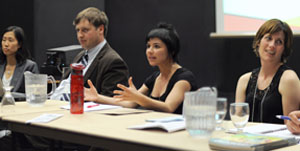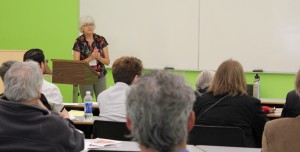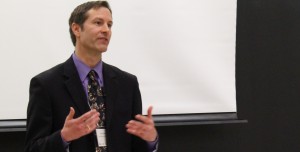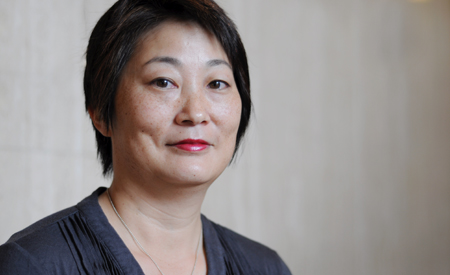
Sarah Bernstein, Experience Congress 2011
University of Regina’s Jill Arkles spoke Tuesday, May 31st, on what she sees as the erosion of gender-based citizenship under Stephen Harper’s Conservatives since they first won a minority government in 2006.
She describes the neo-Conservatives as being supported in large part by a new “Christian Nationalist movement,” pockets of fundamentalist Christians who would see the church institutionalized within the state, able to affect public policy. She notes that, after all, Harper himself considers “faith, family, and freedom” to be the “three pillars” of the Conservative party.
Women, Arkles said, have seen their rights incrementally and substantially eroded through CPC policy, legislation, and inaction. She cites, among other things, a willful lack of action to end racialized and sexualized violence against indigenous women. Arkles also points to the defunding of organizations responsible for research and advocacy, such as Status of Women Canada as measures that effectively silence women’s voices.
Such measures are sometimes implemented by stealth, under the guise of promoting equality. Harper’s plan for childcare support, for instance, restricted single mothers from full-time work by cutting a $5-million day care plan in favour of monthly $100 stipends for families with children under the age of six. Arkles sees this, together with new bonus stipends for two-parent families, as incentivizing the nuclear family. More recently, in the 2011 election, the CPC’s platform emphasized “family values” and income-splitting, more signs that the nuclear family is being. Arkles sees this as revealing the CPC’s direct ideological link to the Christian Nationalist movement.
On the subject of women’s reproductive rights, Arkles has a lot to say. She feels that, though Harper himself has said he will not reopen the debate, with a majority, far-right members will be able to push through anti-choice bills like the Unborn Victims of Crime Act, ostensibly tabled to end violence against pregnant women. In fact, the Act, tabled by Conservative Ken Epp, would not have protected the mother, only the fetus, by granting it ‘personhood,’ a move that would have led to recriminalizing abortion.
For Arkles, these measure amount, in totality, to a war on women. “Without access to funding for research and advocacy, and without the long-form census, women’s rights are in jeopardy,” she says. “These issues have become really personal for me, and I have a lot of fear going forward. That said, this election has marked a sea change in Canadian politics; women have a record number of seats.”
Arkles suggests that it’s important to use that progressive momentum to build social movements around justice issues – like gender-based citizenship rights – and challenge and hold our government accountable.
Photo courtesy of S.L.M. on Flickr












![bouchard_fraser[1] bouchard_fraser[1]](../../wp-content/uploads/2011/06/bouchard_fraser1.jpg)
![Chief_Wilton_Littlechild[1]](../../wp-content/uploads/2011/06/Chief_Wilton_Littlechild1.jpg)
![Antonine_web[1]](../../wp-content/uploads/2011/06/Antonine_web1.jpg)
![David_Adams_web[1]](../../wp-content/uploads/2011/06/David_Adams_web1.jpg)
![Shawn_Atleo_web[1]](../../wp-content/uploads/2011/06/Shawn_Atleo_web1.jpg)
![climate-change-panel2[1]](../../wp-content/uploads/2011/06/climate-change-panel21.jpg)
![bartleman[1]](../../wp-content/uploads/2011/06/bartleman1.jpg)









